This tahini pesto is an oil-free, nut-free, alternative to classic basil pesto. Sesame seed paste gives the pesto an ultra-creamy and smooth consistency. This type of pesto is great for warm or cold pasta dishes, and it’s also a versatile, fresh sauce for summer grain bowls, sandwiches, and salads.
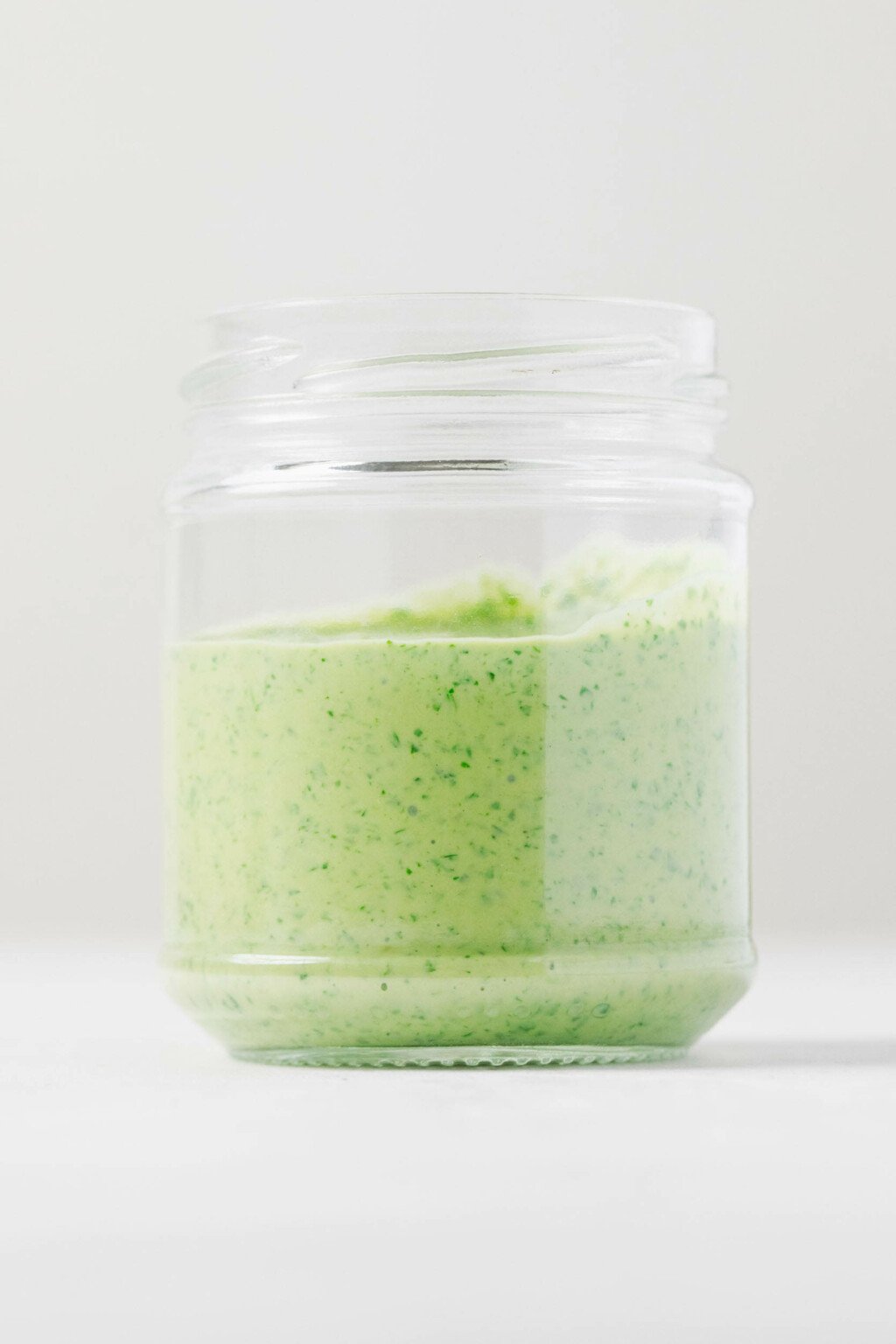
Days are long, temperatures are hot, and tomatoes are juicy.
It’s peak summer, friends. Which means that it’s high time for pesto.
The plant-based pesto recipe that I’m sharing today is different from the more “classic” vegan pesto recipe that lives on this blog.
That version is a vegan pesto with basil and cashews.
This is a vegan tahini pesto—in other words, a pesto recipe that uses one of my favorite ingredients, tahini, as a base.
Why tahini?
Let’s be honest: traditional pesto is a beautiful thing.
For years now, the simple swap of using nutritional yeast or cashew parmesan in place of parmesan cheese has allowed me to easily create a vegan version of the Genovese sauce.
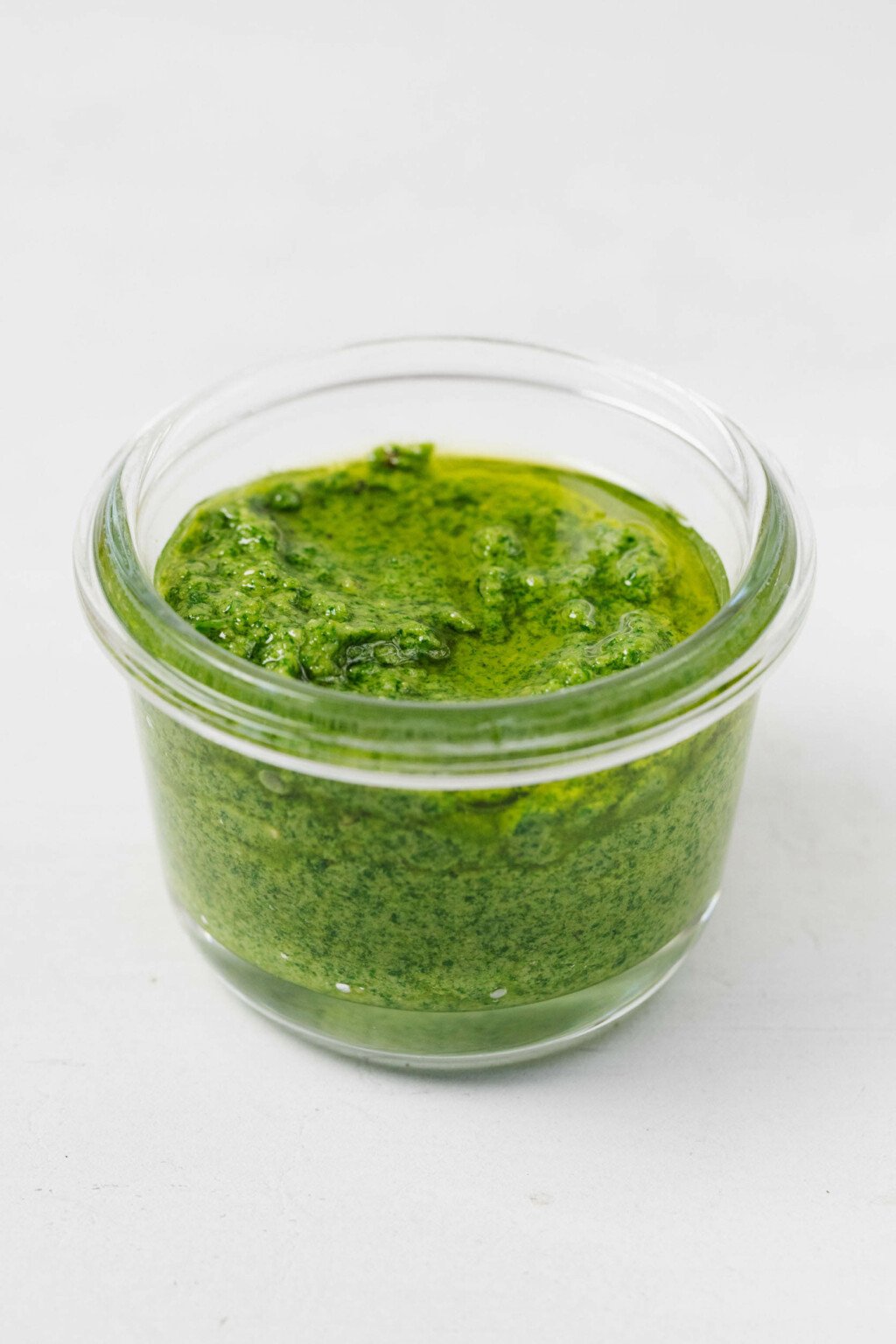
So, why mess with perfection?
That creamy texture!
The main reason that I sometimes like to replace the usual combination of olive oil and nuts with tahini in pesto is to create a creamy texture.
My regular pesto is already on the thicker and creamier side, as opposed to versions that are more coarse and oily.
But this version is extra creamy and smooth. Tahini, or ground sesame paste, is to thank for that texture.
Imagine all of the creaminess of a tahini dressing recipe, but with flecks of fresh, green basil all throughout.


I love that consistency. Whereas regular pesto pasta can be a little “grainy” in texture, the pastas that you create with tahini pesto will be silky and rich.
Allergy-friedlier
While it’s possible to have both nut and seed allergies, there are folks who are allergic to tree nuts but not to seeds.
If you have a tree nut allergy, then the pine nuts, walnuts, or cashews in traditional pesto may not work for you.
Sesame allergy is also common, but it’s less prevalent than tree nut allergies.
Many people who have tree nut allergies can tolerate pumpkin, sunflower, and sesame seeds. As a result, tahini pesto is a more inclusive option.
An oil-free pesto
Olive oil plays a big role in my kitchen and, consequently, in my recipes. But I know that I have readers who adhere to whole foods, plant-based diets, and that many of them choose to avoid oils.
As a result, I’m always happy when I can offer no oil recipe options to my community.
Most of my tahini dressings fit into that category, as do many of the options in my collection of vegan sauce recipes.
Tahini pesto, unlike the traditional pesto that’s decidedly oil-forward, is oil-free.
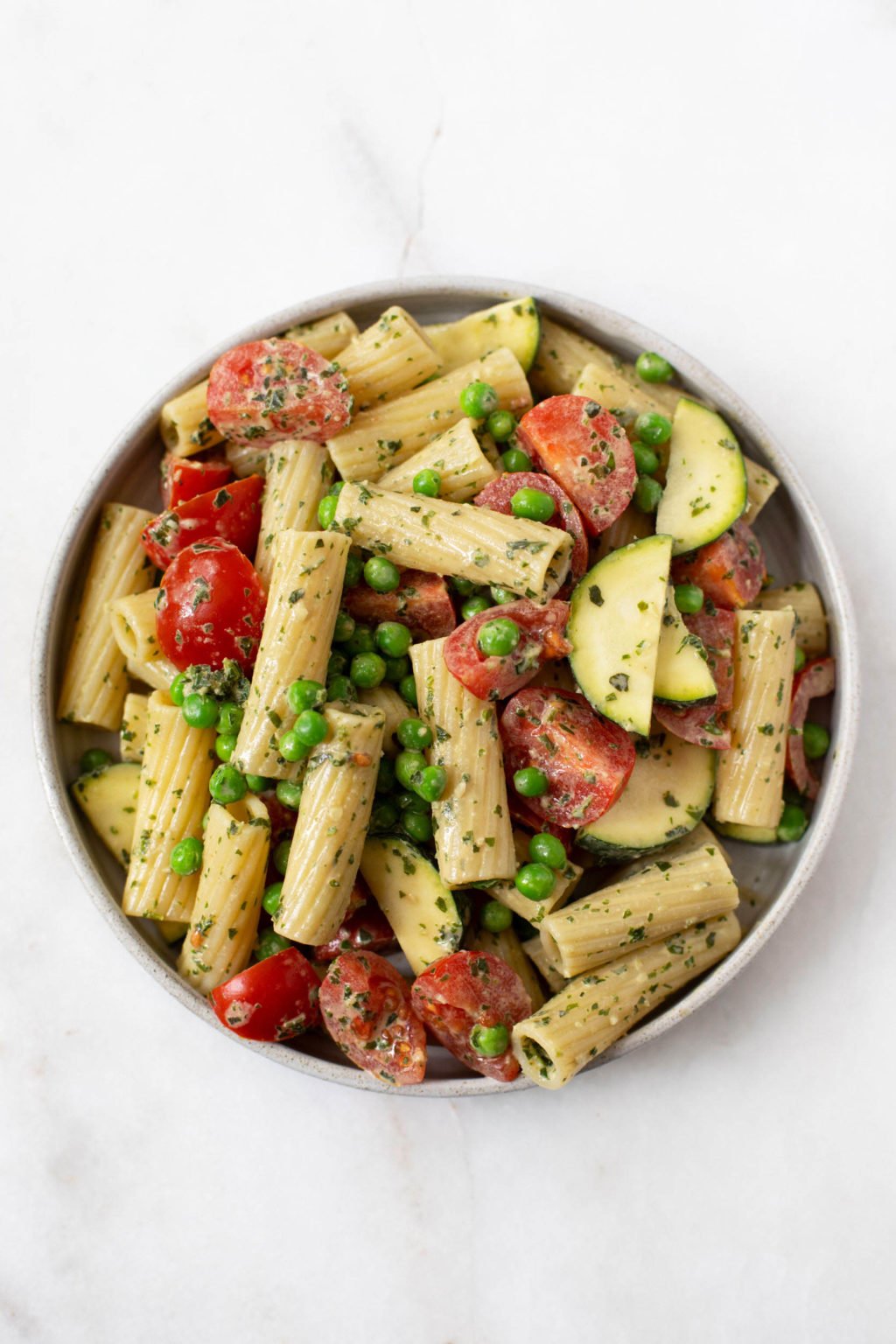
It’s the answer for those who love a bowl of summery pesto pasta, but not one that relies on olive oil as a main ingredient.
The basil: to blanch or not to blanch?
In the past, I’ve mentioned falling in love with the technique of blanching and then icing basil before blending it into pesto.
This happens in three steps: first, adding basil leaves to boiling water for about thirty seconds, then shocking them in an ice bath, then patting them (very) dry.
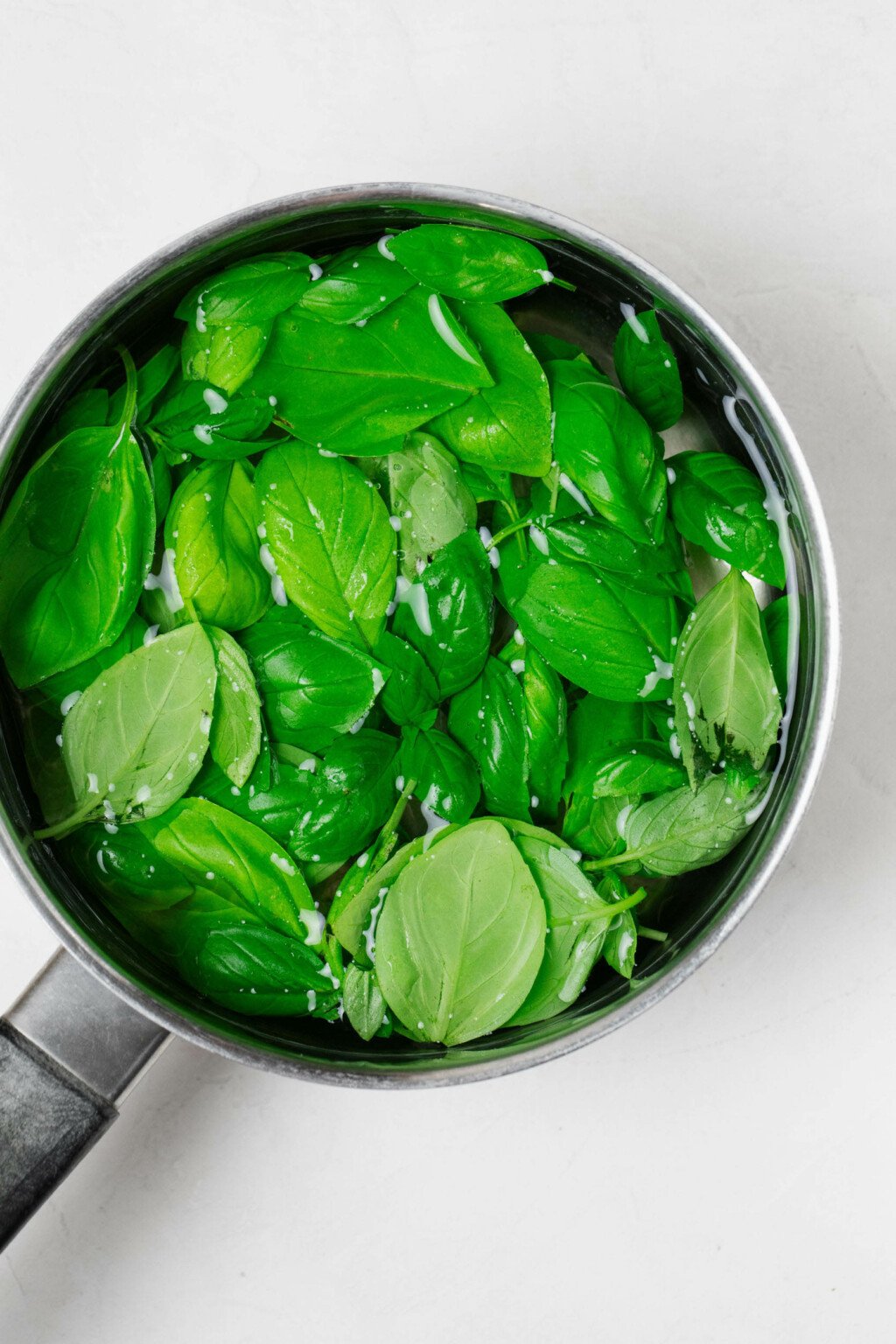
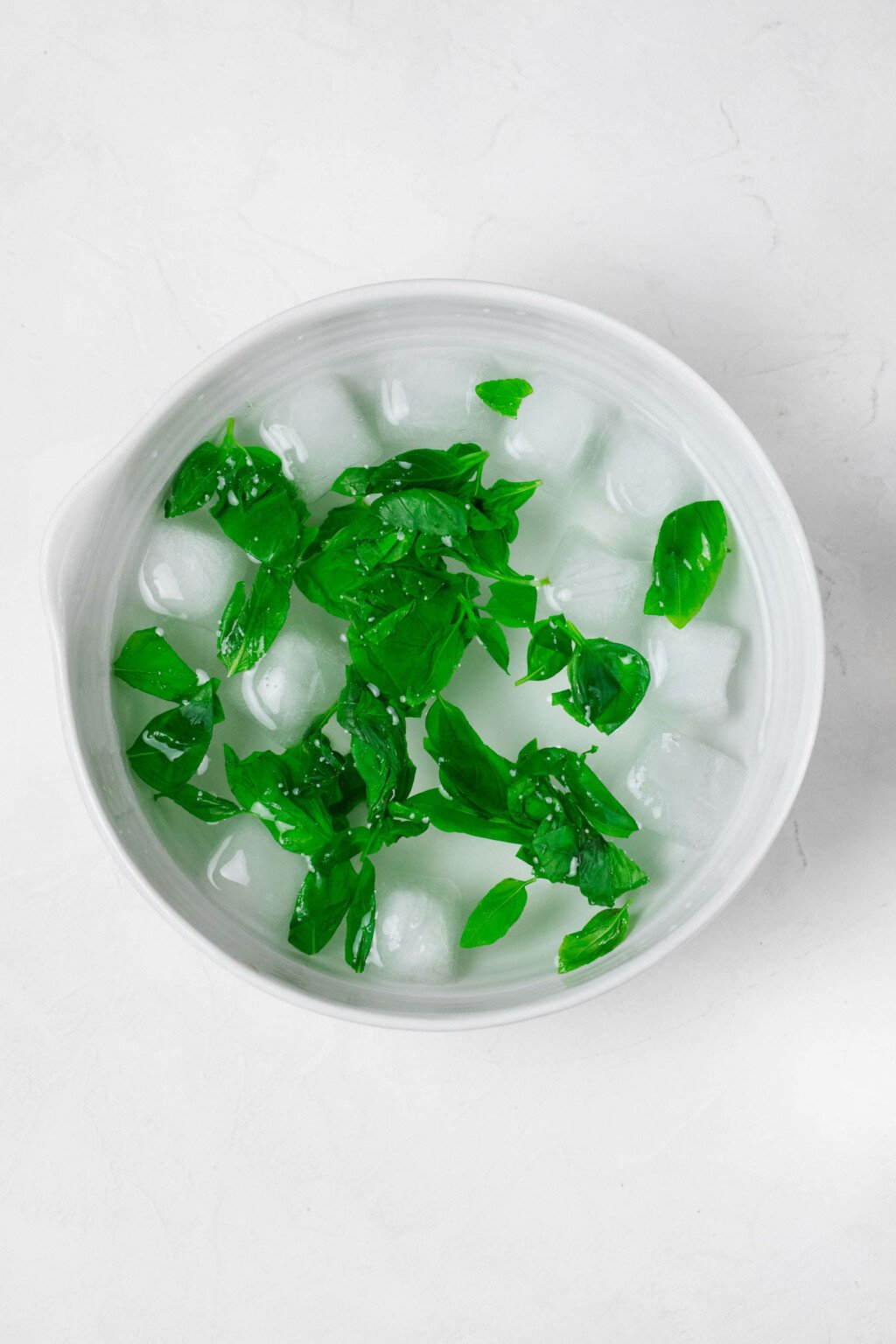
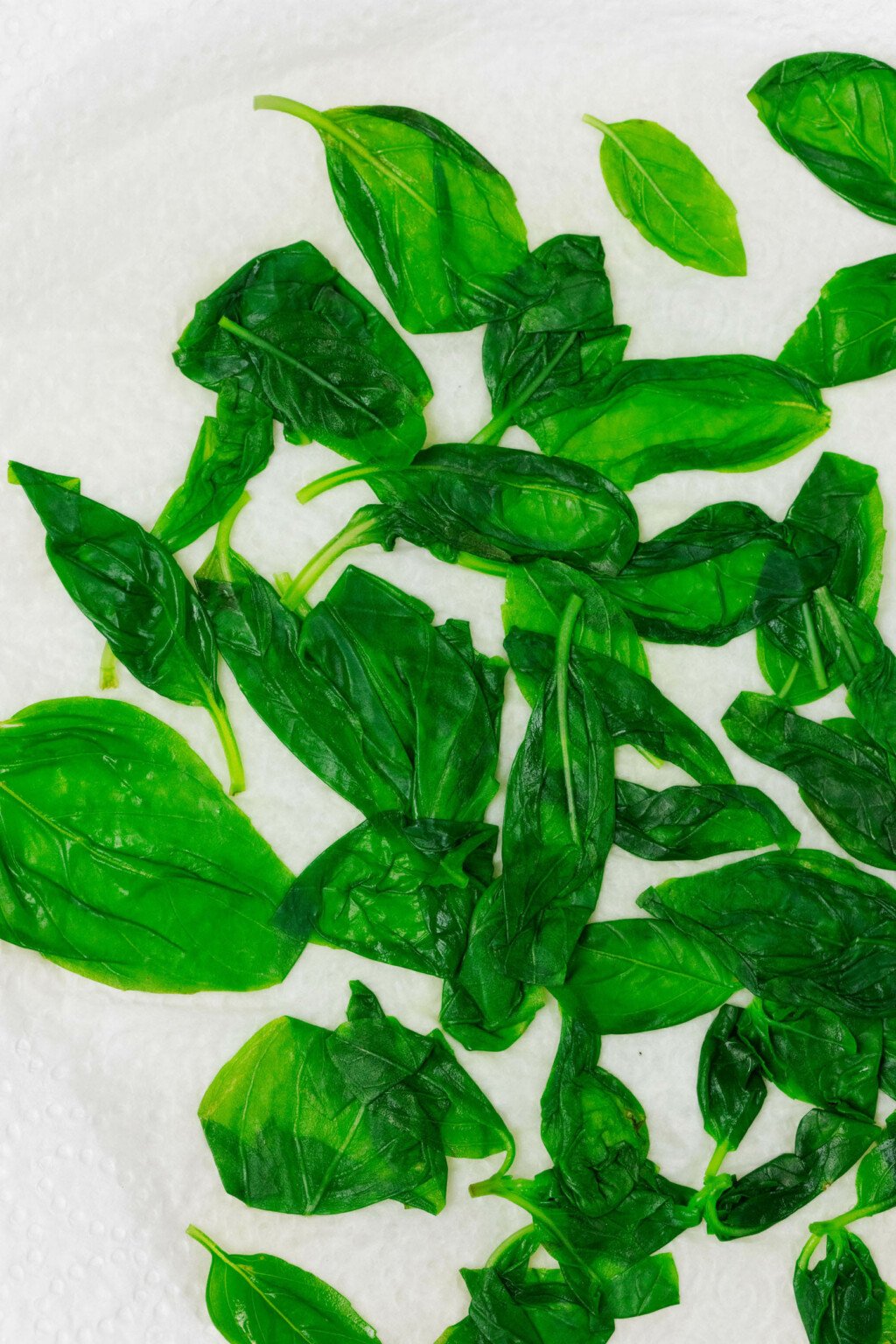
Why go to all this trouble?
Two reasons. First, it actually helps to create a more creamy pesto, which is apropos for the tahini pesto that I’m sharing today.
Second, blanching the basil helps to prevent the browning that’s so commonplace as a jar of pesto is stored in the fridge.
While slight browning doesn’t bother many people, it does bother me!
I love the enduring, bright green color and bright flavor of pesto that’s made with blanched basil. So, it has become my default to make it that way.
In the recipe card for this recipe, I offer both options: blanching and not blanching the basil prior to processing. If speed and convenience are your priority, then you can forgo blanching.
If you live alone and like to store basil for a few days and are turned off by discoloration, then maybe give blanching a try? I think it’s really worthwhile (and there are others who agree!).
How to make creamy tahini pesto
Whether you blanch your basil or not, the steps for making it are quite simple. Here’s how the process goes.
Step 1: Gather your ingredients
For this tahini pesto recipe, you can use either all basil or a mix of basil and parsley. I’ve made and loved both versions; all-basil is traditional, whereas basil and parsley has a little more peppery, earthy flavor.
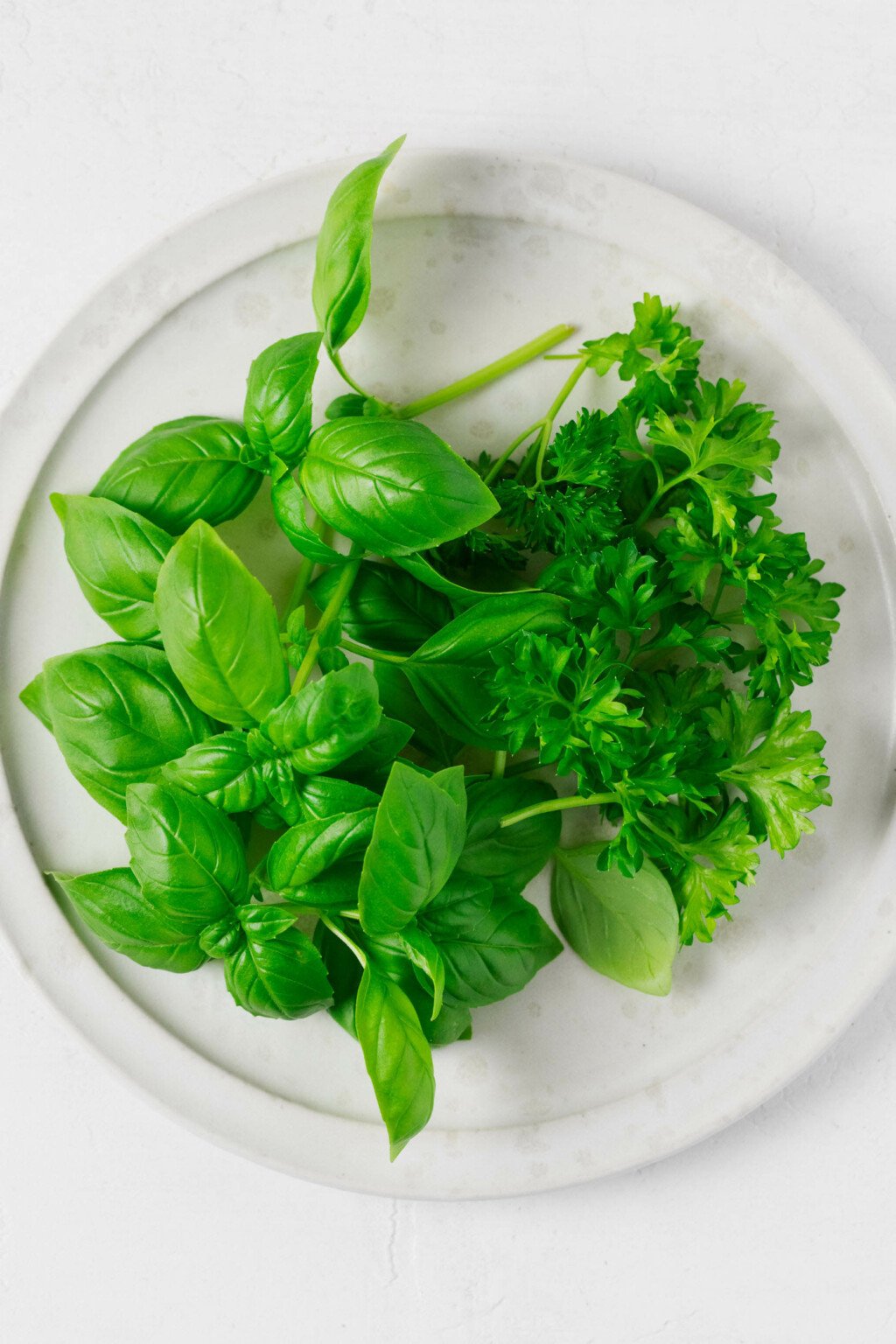
Other ingredients for this recipe:
- Tahini
- Garlic
- Lemon juice
- Nutritional yeast
- Water
- Salt
- Pepper
A note about the tahini: tahini can be either raw, which is pretty uncommon, or made with toasted sesame seeds. I recommend the latter, as it’s easier to find, cheaper, and, I think, tastes better.
Step 2: Blanch the basil (if you want to)
To do this, bring a pot of water to a boil. Add your basil leaves and blanch them for about 15 seconds.
Use a slotted spoon to remove them from the water, then transfer them immediately to an ice bath. Shock them for a few minutes.
Then, transfer the basil leaves to tea towels or paper towels. Squeeze them firmly to get the excess moisture out. At this point, you can use them in the pesto recipe.
If you’re not blanching, go ahead and move forward to step 3.
Step 3: Process
For the next step, all you need to do is transfer all of your ingredients, minus the water, to a food processor fitted with the S blade.
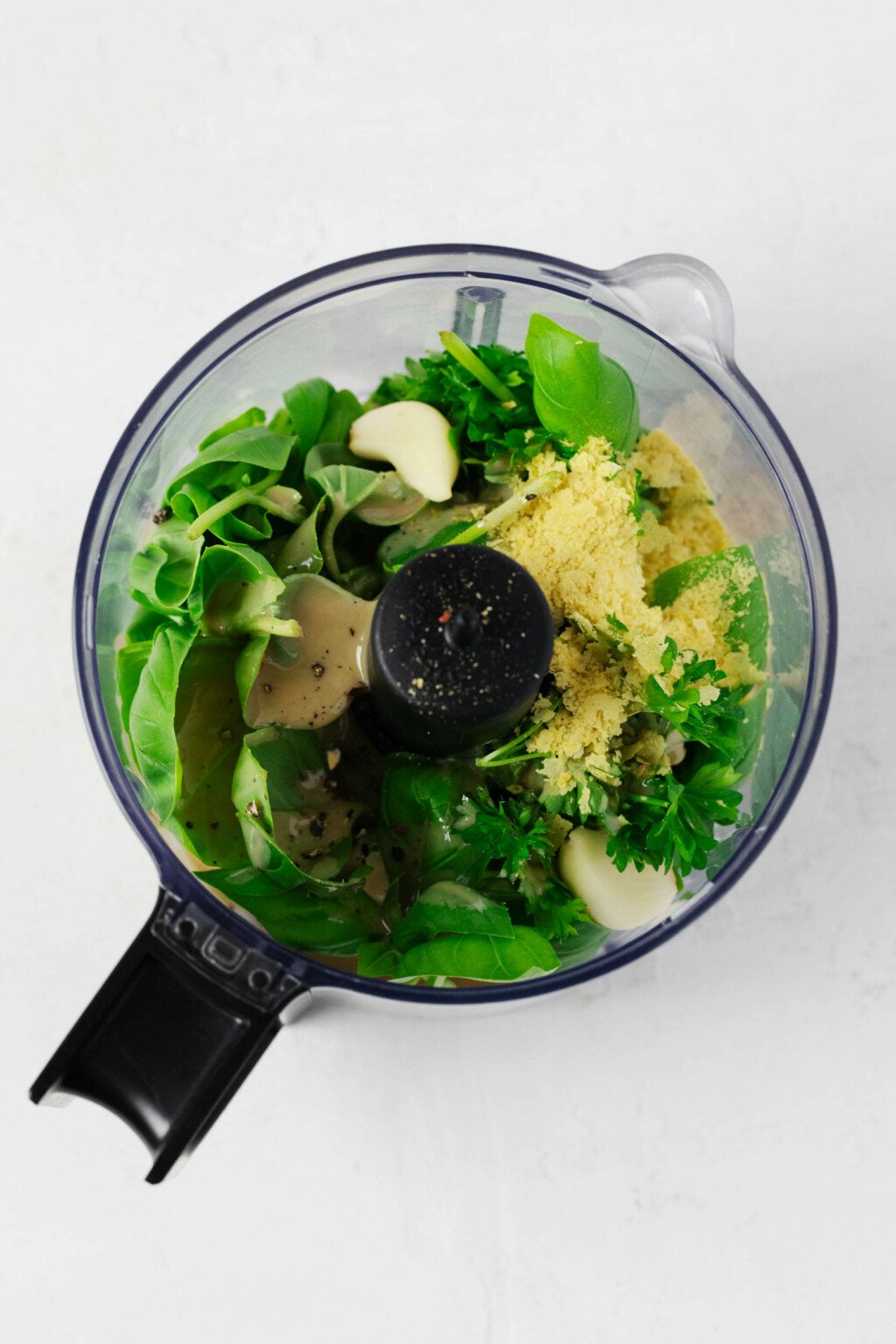
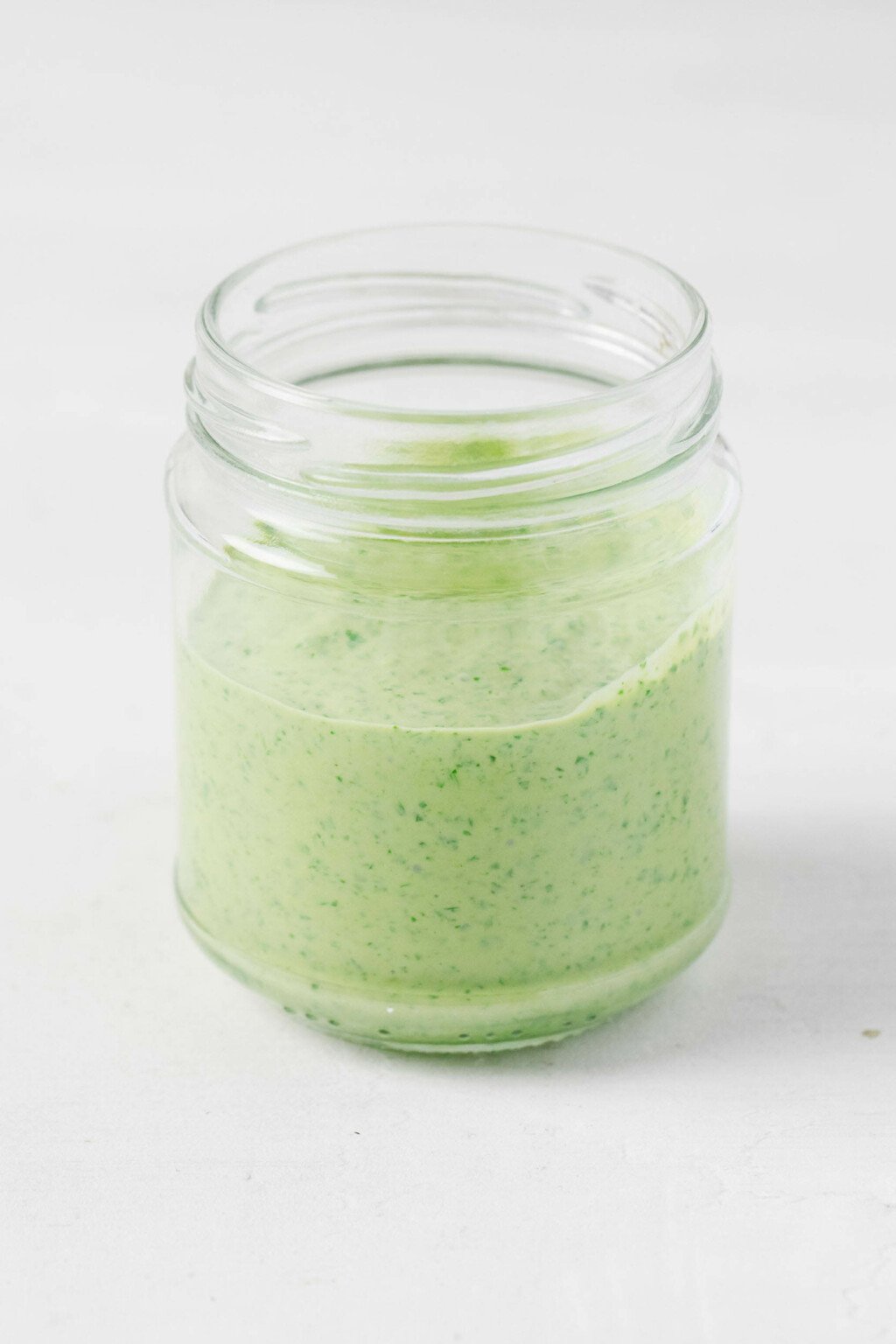
Pulse the ingredients 10-15 times, enough to break down the herbs.
Then, turn the processor on. Drizzle the water into the pouring spout. Blend the pesto for about a minute, then stop the machine to scrape the sides down.
Keep processing for another minute or two, until the pesto is smooth and creamy. You’re aiming for the texture of a thick sauce—so, a bit thicker than a tahini dressing.
Keep processing until the sauce is pretty smooth (it’s fine if some of the herbs are visible).
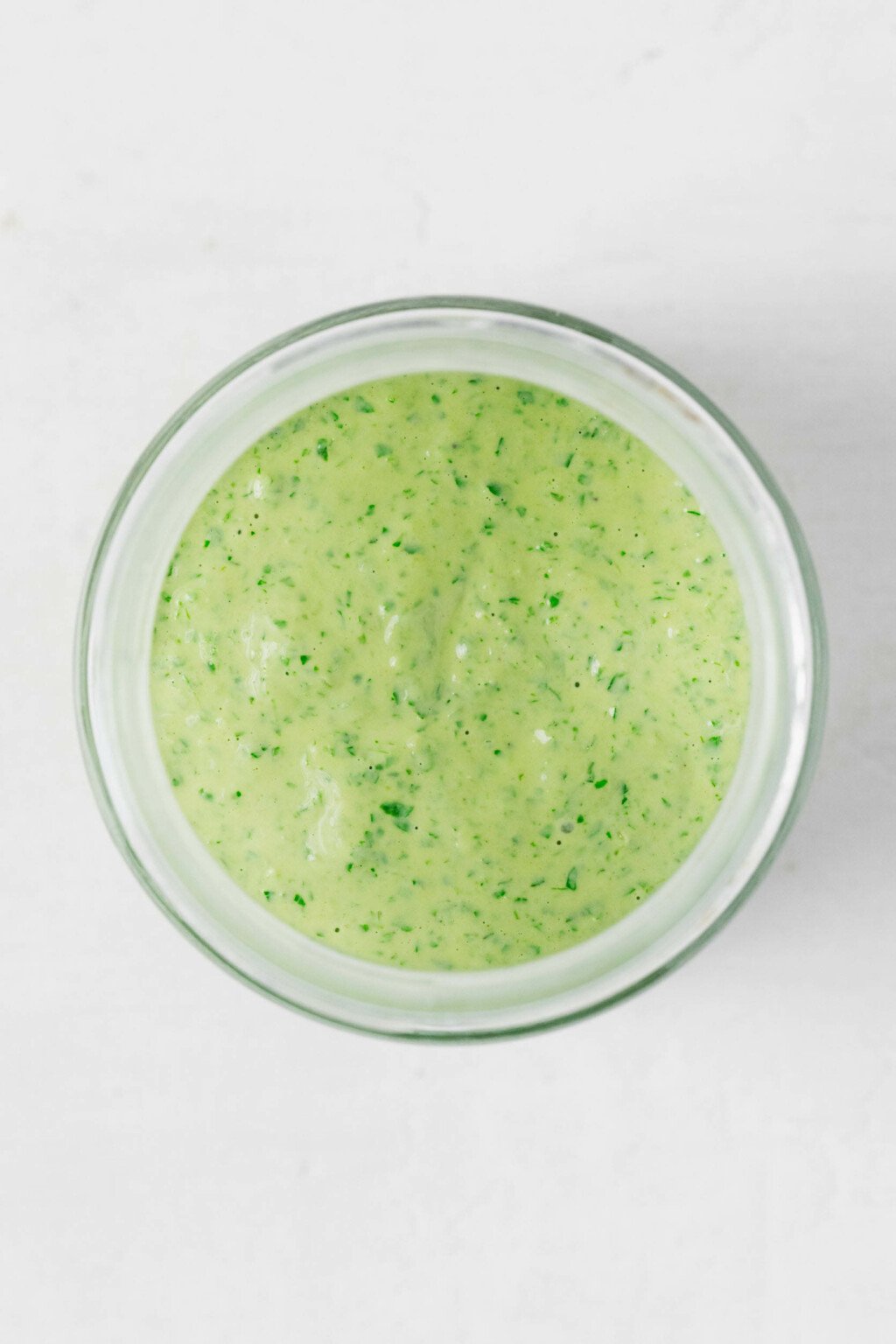
Finally, taste the tahini pesto sauce. Adjust the lemon, salt and pepper as needed.
At this point, your tahini pesto is ready to serve, or you can store it in the fridge for up to four days. You can also freeze the pesto for up to eight weeks.
Serving suggestions for tahini pesto
You can use the tahini pesto in just about any recipe that calls for traditional pesto. Here are some ideas to get you started:
- Pesto farro salad with kale and smoky tofu
- Chickpea pesto pasta salad
- Pesto white bean bowls
- White bean broccoli dip with pesto
- Tahini pesto pasta salad
If adding to pasta, you can add a splash of hot pasta water to thin the tahini pesto, or you can leave it just the way it is for a thicker sauce.
And, for what it’s worth, there’s a pretty great recipe for tahini pesto pasta with broccoli in The Vegan Week. If you’re curious about that version, you can find the recipe on the Seed & Mill website.
Onto the recipe!

Creamy Tahini Pesto
Equipment
Ingredients
- 2 cups tightly packed basil leaves (30g; substitute 1 1/2 cups / 20g tightly packed basil leaves and 1/2 cup / 10g tightly packed parsley)
- 6 tablespoons tahini (90g)
- 2 cloves garlic, roughly chopped
- 1/2 teaspoon salt
- 1 1/2 tablespoons freshly squeezed lemon juice
- 1 tablespoon nutritional yeast
- 1/4 cup water (60ml)
Instructions
Optional: Blanch Your Basil Leaves (to prevent browning)
-
Bring a medium pot of water to a boil over high heat. While the water is heating up, prepare an ice bath in a medium sized bowl.
-
Add the basil to the hot water. Blanch for 15 seconds, then use a slotted spoon to transfer the basil to the ice bath. By the time you transfer all of it, most of the basil will have blanched for about 30 seconds.
-
Allow the basil to remain in the ice bath for 3-5 minutes. Place a few tea towels or paper towels onto your work surface and use the slotted spoon to transfer the basil over to the towels. Use the towels to press the basil firmly, so that you remove all of the excess ice water.
Prepare the Pesto:
-
Transfer your fresh or blanched basil leaves to the bowl of a food processor fitted with the S blade. Add the tahini, garlic, salt, pepper, lemon juice, and nutritional yeast.
-
Pulse 10-15 times, enough to break down the herbs.
-
Turn on the food processor. With the processor running, drizzle in the water through the processor's pouring spout. Process the pesto for a minute. Stop the processor, uncover it, and scrape down the sides of the bowl of the food processor.
-
Recover the food processor and continue processing for another minute, or until you have a creamy, smooth sauce. Add an additional tablespoon of water, if needed, to achieve your desired consistency.
-
Taste the pesto and adjust lemon, salt and pepper as desired. Serve or store in an airtight container in the fridge for up to four days.
At this very moment, I’m thinking about using this delightful sauce on vegan caprese-style sandwiches, along with some of my tofu feta. I bet it’ll be delicious.
Hope you find many wonderful uses for the tahini pesto, too! Enjoy it.
xo
The post Creamy Tahini Pesto appeared first on The Full Helping.